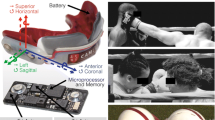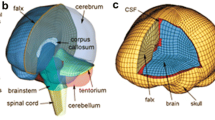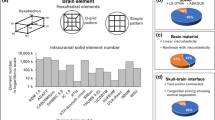Abstract
Brain tissue deformation resulting from head impacts is primarily caused by rotation and can lead to traumatic brain injury. To quantify brain injury risk based on measurements of kinematics on the head, finite element (FE) models and various brain injury criteria based on different factors of these kinematics have been developed, but the contribution of different kinematic factors has not been comprehensively analyzed across different types of head impacts in a data-driven manner. To better design brain injury criteria, the predictive power of rotational kinematics factors, which are different in (1) the derivative order (angular velocity, angular acceleration, angular jerk), (2) the direction and (3) the power (e.g., square-rooted, squared, cubic) of the angular velocity, were analyzed based on different datasets including laboratory impacts, American football, mixed martial arts (MMA), NHTSA automobile crashworthiness tests and NASCAR crash events. Ordinary least squares regressions were built from kinematics factors to the 95% maximum principal strain (MPS95), and we compared zero-order correlation coefficients, structure coefficients, commonality analysis, and dominance analysis. The angular acceleration, the magnitude and the first power factors showed the highest predictive power for the majority of impacts including laboratory impacts, American football impacts, with few exceptions (angular velocity for MMA and NASCAR impacts). The predictive power of rotational kinematics about three directions (x: posterior-to-anterior, y: left-to-right, z: superior-to-inferior) of kinematics varied with different sports and types of head impacts.





Similar content being viewed by others
References
Bain, A. C., and D. F. Meaney. Tissue-level thresholds for axonal damage in an experimental model of central nervous system white matter injury. J. Biomech. Eng. 122(6):615–622, 2000.
Bar-Kochba, E., et al. Strain and rate-dependent neuronal injury in a 3D in vitro compression model of traumatic brain injury. Sci. Rep. 6(1):1–11, 2016.
Bartsch, A. J., et al. High energy side and rear american football head impacts cause obvious performance decrement on video. Ann. Biomed. Eng. 48:2667, 2020.
Budescu, D. V. Dominance analysis: a new approach to the problem of relative importance of predictors in multiple regression. Psychol. Bull. 114(3):542, 1993.
Camarillo, D. B., et al. An instrumented mouthguard for measuring linear and angular head impact kinematics in American football. Ann. Biomed. Eng. 41(9):1939–1949, 2013.
Cater, H. L., L. E. Sundstrom, and B. Morrison III. Temporal development of hippocampal cell death is dependent on tissue strain but not strain rate. J. Biomech. 39(15):2810–2818, 2006.
Courville, T., and B. Thompson. Use of structure coe_cients in published multiple regression articles: β is not enough. Educ. Psychol. Measur. 61(2):229–248, 2001.
Donat, C. K., et al. From biomechanics to pathology: predicting axonal injury from patterns of strain after traumatic brain injury. Brain 144(1):70–91, 2021.
Efron, B., and R. J. Tibshirani. An Introduction to the Bootstrap. Boca Raton: CRC Press, 1994.
Fahlstedt, M., et al. Correlation between injury pattern and finite element analysis in biomechanical reconstructions of traumatic brain injuries. J. Biomech. 48(7):1331–1335, 2015.
Fahlstedt, M., et al. Ranking and rating bicycle helmet safety performance in oblique impacts using eight different brain injury models. Ann. Biomed. Eng. 49:1097–1109, 2021.
Gabler, L. F., J. R. Crandall, and M. B. Panzer. Development of a second-order system for rapid estimation of maximum brain strain. Ann. Biomed. Eng. 47(9):1971–1981, 2019.
Gabler, L. F., et al. Development of a single-degree-of-freedom mechanical model for predicting strain-based brain injury responses. J. Biomech. Eng. 140(3), 2018.
Gennarelli, T. A., et al. Axonal injury in the optic nerve: a model simulating diffuse axonal injury in the brain. J. Neurosurg. 71(2):244–253, 1989.
Ghazi, K., et al. Instantaneous whole-brain strain estimation in dynamic head impact. J. Neurotrauma 38:1023, 2020.
Giudice, J. S., et al. Development of open-source dummy and impactor models for the assessment of American football helmet finite element models. Ann. Biomed. Eng. 47(2):464–474, 2019.
Güiza, F., et al. Early detection of increased intracranial pressure episodes in traumatic brain injury: external validation in an adult and in a pediatric cohort. Crit. Care Med. 45(3):e316–e320, 2017.
Hajiaghamemar, M., and S. S. Margulies. Multi-scale white matter tract embedded brain finite element model predicts the location of traumatic diffuse axonal injury. J. Neurotrauma 38(1):144–157, 2021.
Hernandez, F., et al. Lateral impacts correlate with falx cerebri displacement and corpus callosum trauma in sports-related concussions. Biomech. Model. Mechanobiol. 18(3):631–649, 2019.
Ho, J., and S. Kleiven. Dynamic response of the brain with vasculature: a three-dimensional computational study. J. Biomech. 40(13):3006–3012, 2007.
Holbourn, A. H. S. Mechanics of head injuries. The Lancet 242(6267):438–441, 1943.
James, G., et al. An Introduction to Statistical Learning, Vol. 112. New York: Springer, 2013.
James, S. L., et al. Global, regional, and national burden of traumatic brain injury and spinal cord injury, 1990–2016: a systematic analysis for the Global Burden of Disease Study 2016. Lancet Neurol. 18(1):56–87, 2019.
Kang, W. H., and B. Morrison. Functional tolerance to mechanical deformation developed from organotypic hippocampal slice cultures. Biomech. Model. Mechanobiol. 14(3):561–575, 2015.
Kimpara, H., et al. Head injury prediction methods based on 6 degree of freedom head acceleration measurements during impact. Int. J. Autom. Eng. 2(2):13–19, 2011.
Kimpara, H., and M. Iwamoto. Mild traumatic brain injury predictors based on angular accelerations during impacts. Ann. Biomed. Eng. 40(1):114–126, 2012.
Kleiven, S. Evaluation of head injury criteria using a finite element model validated against experiments on localized brain motion, intracerebral acceleration, and intracranial pressure. Int. J. Crashworthiness 11(1):65–79, 2006.
Laksari, K., et al. Multi-directional dynamic model for traumatic brain injury detection. J. Neurotrauma 37(7):982–993, 2020.
Li, X., Z. Zhou, and S. Kleiven. An anatomically detailed and personalizable head injury model: significance of brain and white matter tract morphological variability on strain. Biomech. Model. Mechanobiol. 20(2):403–431, 2021.
Liu, Y., et al. Theoretical and numerical analysis for angular acceleration being determinant of brain strain in mTBI. arXiv preprint arXiv:2012.13507, 2020.
Liu, Yuzhe, et al. Validation and comparison of instrumented mouthguards for measuring head kinematics and assessing brain deformation in football impacts. Ann. Biomed. Eng. 48(11):2580–2598, 2020.
Liu, Y., et al. Time window of head impact kinematics measurement for calculation of brain strain and strain rate in American football. arXiv preprint arXiv:2102.05728, 2021.
McAllister, T. W., et al. Maximum principal strain and strain rate associated with concussion diagnosis correlates with changes in corpus callosum white matter indices. Ann. Biomed. Eng. 40(1):127–140, 2012.
Montenigro, P. H., et al. Cumulative head impact exposure predicts later-life depression, apathy, executive dysfunction, and cognitive impairment in former high school and college football players. J. Neurotrauma 34(2):328–340, 2017.
Nathans, L. L., F. L. Oswald, and K. Nimon. Interpreting multiple linear regression: a guidebook of variable importance. Pract. Assess. Res. Eval. 17(1):9, 2012.
National Highway Traffic Safety Administration. Data. NHTSA, 18 May 2020. www.nhtsa.gov/data.
O’Keeffe, E., et al. Dynamic blood–brain barrier regulation in mild traumatic brain injury. J. Neurotrauma 37(2):347–356, 2020.
Post, A., et al. Traumatic brain injuries: the inuence of the direction of impact. Neurosurgery 76(1):81–91, 2015.
Prunier, J. G., et al. Multicollinearity in spatial genetics: separating the wheat from the chaff using commonality analyses. Mol. Ecol. 24(2):263–283, 2015.
Ray-Mukherjee, J., et al. Using commonality analysis in multiple regressions: a tool to decompose regression effects in the face of multicollinearity. Methods Ecol. Evol. 5(4):320–328, 2014.
Rowson, S., and S. M. Duma. Brain injury prediction: assessing the combined probability of concussion using linear and rotational head acceleration. Ann. Biomed. Eng. 41(5):873–882, 2013.
Sanchez, E. J., et al. A reanalysis of football impact reconstructions for head kinematics and finite element modeling. Clin. Biomech. 64:82–89, 2019.
Sarkar, S., S. Majumder, and A. Roychowdhury. Factors affecting diffuse axonal injury under blunt impact and proposal for a head injury criteria: a finite element analysis. Crit. Rev. Biomed. Eng. 46(4):289, 2018.
Semmel, S. Multiple regression in industrial organizational psychology: relative importance and model sensitivity, 2018.
Takhounts, E. G., et al. Development of brain injury criteria (BrIC). No. 2013-22-0010. SAE Technical Paper, 2013.
Takhounts, E. G., et al. Kinematic rotational brain injury criterion (BRIC). Proceedings of the 22nd Enhanced Safety of Vehicles Conference. Paper. No. 11-0263. 2011.
Tiernan, S., and G. Byrne. The effect of impact location on brain strain. Brain Inj. 33(4):427–434, 2019.
Tiernan, S., et al. Concussion and the severity of head impacts in mixed martial arts. Proc. Inst. Mech. Eng. H, 2020.
Tse, K. M., et al. Effect of helmet liner systems and impact directions on severity of head injuries sustained in ballistic impacts: a finite element (FE) study. Med. Biol. Eng. Comput. 55(4):641–662, 2017.
Versace, J. A review of the severity index. No. 710881. SAE Technical Paper, 1971.
Weaver, A. A., K. A. Danelson, and J. D. Stitzel. Modeling brain injury response for rotational velocities of varying directions and magnitudes. Ann. Biomed. Eng. 40(9):2005–2018, 2012.
Wu, S., et al. Convolutional neural network for efficient estimation of regional brain strains. Sci. Rep. 9(1):1–11, 2019.
Yanaoka, T., Y. Dokko, and Y. Takahashi. Investigation on an injury criterion related to traumatic brain injury primarily induced by head rotation. No. 2015-01-1439. SAE Technical Paper, 2015.
Zhan, X., et al. The relationship between brain injury criteria and brain strain across different types of head impacts can be different. J. R. Soc. Interface 18:20210260, 2021.
Zhan, X., et al. Rapid estimation of entire brain strain using deep learning models. IEEE Transactions on Bio-medical Engineering, 2021.
Zhao, W., and S. Ji. White matter anisotropy for impact simulation and response sampling in traumatic brain injury. J. Neurotrauma 36(2):250–263, 2019.
Zhou, Z., et al. A reanalysis of experimental brain strain data: implication for finite element head model validation. SAE 62nd Stapp Car Crash Conference, STAPP 2018; Catamaran Resort Hotel San Diego; United States; 12 November 2018 through 14 November 2018. Vol. 2019. SAE International, 2019.
Zhou, Z., Li, X., Liu, Y., Fahlstedt, M., Georgiadis, M., Zhan, X., Raymond, S.J., Grant, G., Kleiven, S., Camarillo, D. Towards a comprehensive delineation of white matter tract-related deformation. bioRxiv, 2021.
Acknowledgements
This research was supported by the Pac-12 Conference’s Student-Athlete Health and Well-Being Initiative, the National Institutes of Health (R24NS098518), Taube Stanford Children’s Concussion Initiative and Stanford Department of Bioengineering. The authors also want to express their gratitude for the insights from the linear model course (STATS305A) offered by Dr. Trevor Hastie at Stanford University.
Author information
Authors and Affiliations
Corresponding author
Additional information
Associate Editor Stefan M. Duma oversaw the review of this article.
Publisher's Note
Springer Nature remains neutral with regard to jurisdictional claims in published maps and institutional affiliations.
Supplementary Information
Below is the link to the electronic supplementary material.
Rights and permissions
About this article
Cite this article
Zhan, X., Li, Y., Liu, Y. et al. Predictive Factors of Kinematics in Traumatic Brain Injury from Head Impacts Based on Statistical Interpretation. Ann Biomed Eng 49, 2901–2913 (2021). https://doi.org/10.1007/s10439-021-02813-z
Received:
Accepted:
Published:
Issue Date:
DOI: https://doi.org/10.1007/s10439-021-02813-z




